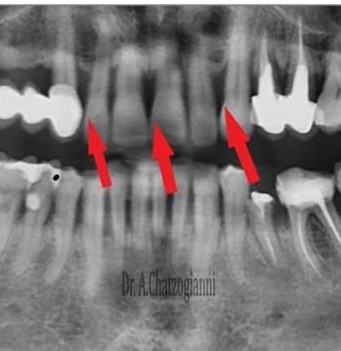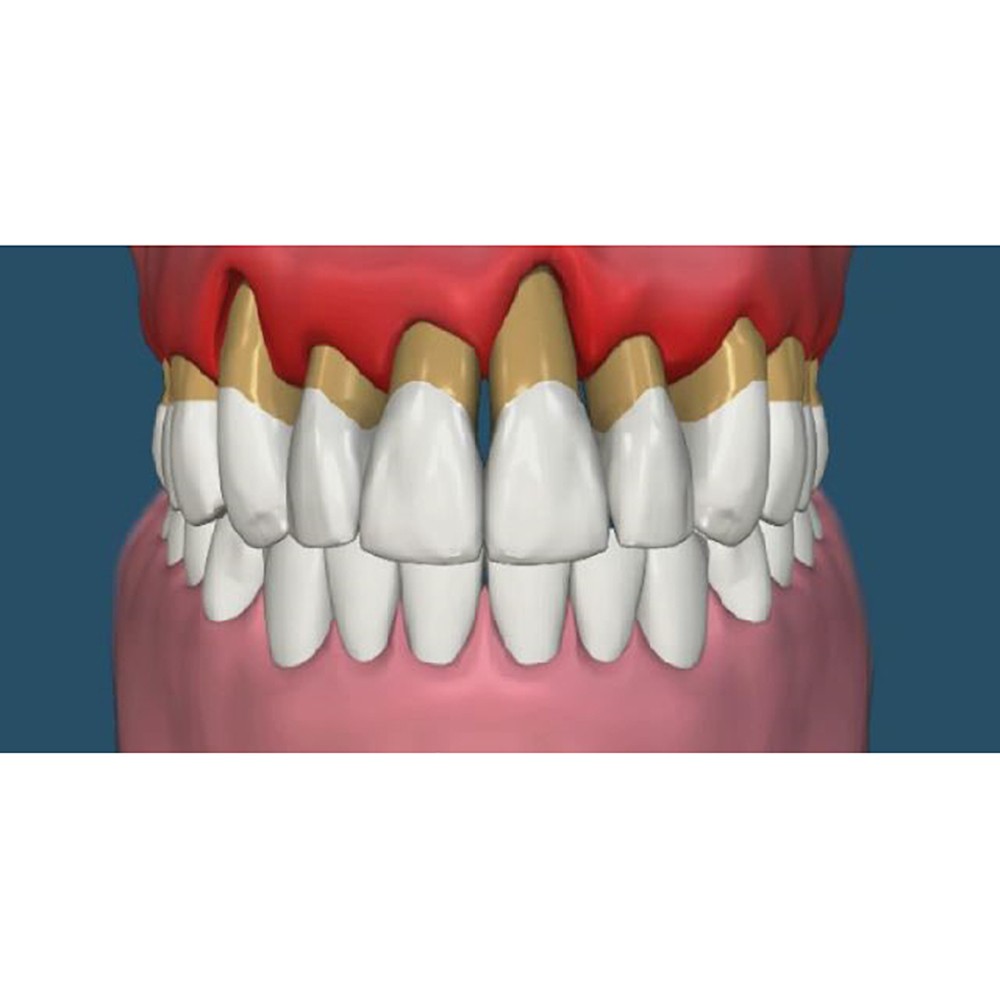Periodontitis is an inflammatory disease which is the main cause of most people’s tooth loss. It is an evolutionary-advanced form of gingivitis, where the germs and toxins gradually progress through the gums into the bone and the supporting tissues (periodontium) of the teeth, with the following result: the teeth initially present a mobility and eventually fall.
SYMPTOMS OF PERIODONTITIS
- bleeding of the gums, even with a simple bite
- red, swollen or enlarged gums
- recession of the gums
- detachment of the gums from the teeth
- outflow of pus between teeth and gums
- looseness and mobility of the teeth
- intense and persistent odour
- teeth that lengthen, change position or weaken
- advanced tooth loss
 CAUSES
CAUSES- microbial dental plaque
- poor oral hygiene
- smoking and high consumption of alcohol and soft drinks
- wound closure of the upper and lower teeth
- diabetes and hormonal disorders (puberty, menstruation, pregnancy, menopause)
- chronic medication
- heredity
- Stress, anxiety
- bad nutrition
- other dental problems (e.g. defective dental bridges and fillings)
For the effective treatment of periodontitis, it is particularly important to imprint the condition of the gums and periodontal pockets. The diagnosis of periodontitis is performed during the clinical examination of the mouth by the dentist, with the help of a special tool, of the periodontal probe which measures the depth of the periodontal pockets, the recessions, the mobility, etc.
 If periodontitis is clinically diagnosed, then radiography checking should be performed to assess the bone support of the teeth.
If periodontitis is clinically diagnosed, then radiography checking should be performed to assess the bone support of the teeth.
Periodontitis is distinguished according to its stage: incipient, moderate and advanced. Depending on the extent of the disease, in localized and generalized periodontitis. Depending on the age of the patient, in aggressive and chronic periodontitis, as well as, depending on the alteration of the bone, in vertical and horizontal periodontitis.
PERIODONTITIS TREATMENT
Periodontitis requires either conservative or surgical treatment.
CONSERVATIVE (non-surgical) TREATMENT
In the first case, subgingival (or radical) scraping is performed. This is about a very deep cleaning process under the gums which is performed under local anesthesia and removes the tartar deposits from the pockets. In this case, laser can also be used. The treatment is done in stages and 1-4 visits are required for it to be completed. Antibiotic coverage is provided by the attending dentist where necessary, as well as special praparations.
SURGICAL TREATMENTSurgery is necessary if the disease is advanced and the inflammation and the deep pockets are not treated by simple cleaning and medication.
 The periodontist, by detaching the gums from the teeth and the bone, removes the tartar and reduces the periodontal pockets to keep the area clean. They also proceed, where necessary, to procedures of regeneration of the tissues, bones, or gums lost due to periodontitis (surgery with specially treated bone grafts). Finally, they restore the gums to their position by placing stitches.
The periodontist, by detaching the gums from the teeth and the bone, removes the tartar and reduces the periodontal pockets to keep the area clean. They also proceed, where necessary, to procedures of regeneration of the tissues, bones, or gums lost due to periodontitis (surgery with specially treated bone grafts). Finally, they restore the gums to their position by placing stitches.
After the periodontal treatment, the dentist gives oral hygiene instructions, while, at the same time, the patient is part of a regular re-checking programme by their dentist, in order for the therapeutic effect to be maintained.
OTHER DISEASES ASSOCIATED WITH PERIODONTITISThe periodontal disease may be associated with other diseases, such as:
- Encephalopathies
- Cardiovascular diseases
- Pulmonary diseases
- Gestational complications (e.g. birth of premature or low birth weight infants)
- Diabetes
- Renal disease
For more information click the link: https://www.chatzogianni.gr/gr/periodontitida


